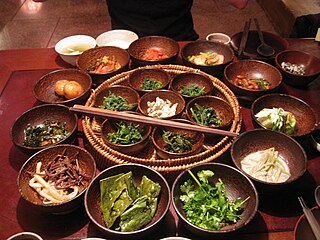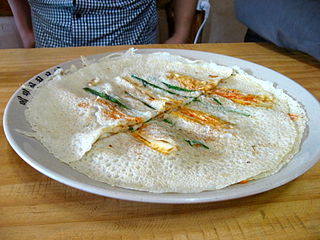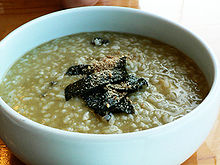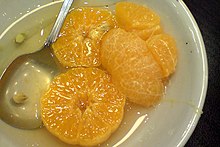
Korean cuisine has evolved through centuries of social and political change. Originating from ancient agricultural and nomadic traditions in Korea and southern Manchuria, Korean cuisine reflects a complex interaction of the natural environment and different cultural trends.

Korean royal court cuisine was the style of cookery within Korean cuisine traditionally consumed at the court of the Joseon Dynasty, which ruled Korea from 1392 to 1910. There has been a revival of this cookery style in the 21st century. It is said that twelve dishes should be served along with rice and soup, with most dishes served in bangjja (bronzeware).

Mak-guksu (막국수) or buckwheat noodles is a Korean buckwheat noodle dish served in a chilled broth and sometimes with sugar, mustard, sesame oil or vinegar. It is a local specialty of the Gangwon province of South Korea, and its capital city, Chuncheon. Jaengban-guksu is a type of makguksu in which buckwheat noodles and various vegetables are mixed in a tray.

Tteok is a class of Korean rice cakes made with steamed flour made of various grains, including glutinous or non-glutinous rice. Steamed flour can also be pounded, shaped, or pan-fried to make tteok. In some cases, tteok is pounded from cooked grains.

Memil-muk (메밀묵) or buckwheat jelly is a light gray-brown muk (jelly) made from buckwheat starch. It is commonly served as banchan as well as anju.

Pajeon is a variety of jeon with scallion as its prominent ingredient, as pa (파) means scallion. It is a Korean dish made from a batter of eggs, wheat flour, rice flour, scallions, and often other ingredients depending on the variety. Beef, pork, kimchi, shellfish, and other seafood are mostly used. If one of these ingredients, such as squid, dominates the jeon, the name will reflect that; e.g. ojing'eo jeon (오징어전) is 'squid jeon'.

Kal-guksu is a Korean noodle dish consisting of handmade, knife-cut wheat flour noodles served in a large bowl with broth and other ingredients. It is traditionally considered a seasonal food, consumed most often in summer. Its name comes from the fact that the noodles are not extruded or spun, but cut.

Korean noodles are noodles or noodle dishes in Korean cuisine, and are collectively referred to as "guksu" in native Korean or "myeon" in hanja character. Preparations with noodles are relatively simple and dates back to around 6000 BCE to 5000 BCE in Asia. In Korea, traditional noodle dishes are onmyeon, called guksu jangguk, naengmyeon, bibim guksu, kalguksu, kongguksu among others. In royal court, baekmyeon consisting of buckwheat noodles and pheasant broth, was regarded as the top quality noodle dish. Naengmyeon, with a cold soup mixed with dongchimi and beef brisk broth, was eaten in court during summer.

Yeot (Korean: 엿) is a variety of hangwa, or Korean traditional confectionery. It can be made in either liquid or solid form, as a syrup, taffy, or candy. Yeot is made from steamed rice, glutinous rice, glutinous sorghum, corn, sweet potatoes, or mixed grains. It is presumed to have been used before the Goryeo period. The steamed ingredients are lightly fermented and boiled in a large pot called a sot for a long time.

Buchimgae (부침개), or Korean pancake, refers broadly to any type of pan-fried ingredients soaked in egg or a batter mixed with other ingredients. More specifically, it is a dish made by pan-frying a thick batter mixed with egg and other ingredients until a thin flat pancake-shaped fritter is formed.

Korean temple cuisine refers to a type of cuisine that originated in Buddhist temples of Korea. Since Buddhism was introduced into Korea, Buddhist traditions have strongly influenced Korean cuisine as well. During the Silla period, chalbapyakgwa and yumilgwa were served for Buddhist altars and have been developed into types of hangwa, Korean traditional confectionery. During the Goryeo Dynasty, sangchu ssam, yaksik, and yakgwa were developed, so spread to China and other countries. Since the Joseon Dynasty, Buddhist cuisine has been established in Korea according to regions and temples.

Memil-buchimgae (메밀부침개) or buckwheat pancake is a variety of buchimgae, or Korean pancake. It is a crepe-like dish made of thin buckwheat batter and napa cabbage.
Korean regional cuisines are characterized by local specialties and distinctive styles within Korean cuisine. The divisions reflected historical boundaries of the provinces where these food and culinary traditions were preserved until modern times.
Chanochi (차노치) is a Korean dish. It is pink, pan-fried tteok or jeonbyeong (pancake) made with glutinous rice flour. It is a regional dish of the Yeongnam region.
















